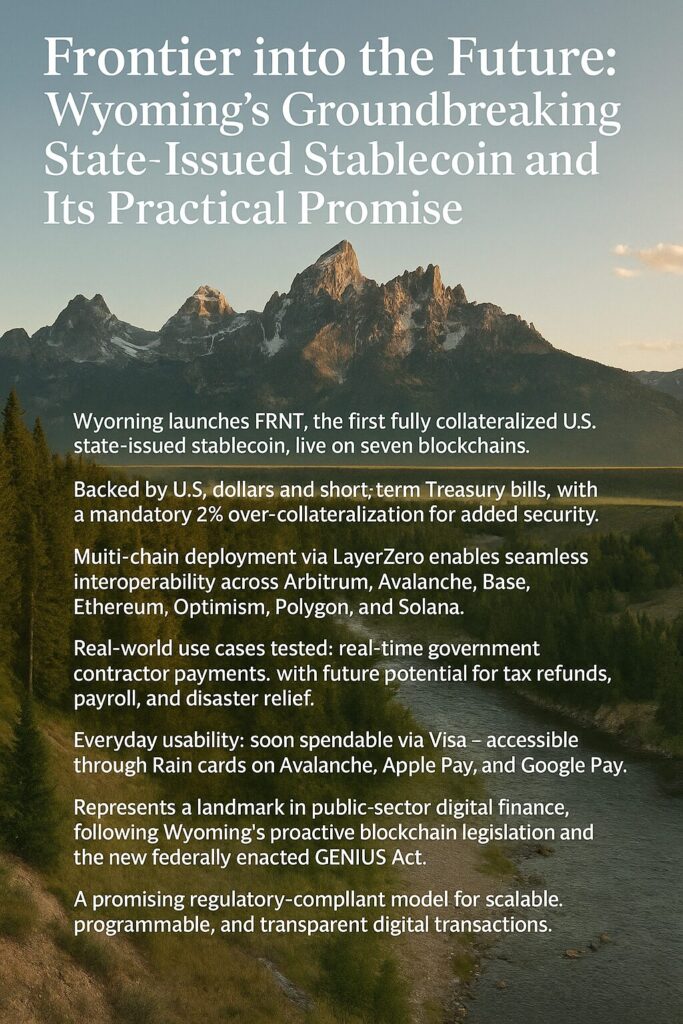
Main Points:
- Wyoming launches FRNT, the first fully collateralized U.S. state-issued stablecoin, live on seven blockchains.
- Backed by U.S. dollars and short-term Treasury bills, with a mandatory 2% over‑collateralization for added security.
- Multi-chain deployment via LayerZero enables seamless interoperability across Arbitrum, Avalanche, Base, Ethereum, Optimism, Polygon, and Solana.
- Real‑world use cases tested: real‑time government contractor payments, with future potential for tax refunds, payroll, and disaster relief.
- Everyday usability: soon spendable via Visa—accessible through Rain cards on Avalanche, Apple Pay, and Google Pay.
- Represents a landmark in public-sector digital finance, following Wyoming’s proactive blockchain legislation and the new federally enacted GENIUS Act.
- A promising regulatory‑compliant model for scalable, programmable, and transparent digital transactions.
1. A New Frontier: What is FRNT?
Wyoming has officially launched the Frontier Stable Token (FRNT), marking the first time in U.S. history that a public-sector entity issues a fully reserved stablecoin. Unlike privately issued stablecoins such as Tether or USDC, FRNT is government-backed, bringing a new paradigm to digital currency issuance.
FRNT is pegged 1:1 to the U.S. dollar and maintained in a trust fund composed of cash and short-duration U.S. Treasury bills. To ensure stability beyond standard practices, Wyoming law mandates a 102% reserve ratio, meaning the token is over-collateralized by 2%. Reserve management is handled by Franklin Advisers, while The Network Firm performs monthly audits and attestations.
2. Multi-Chain on Day One
At launch, FRNT was deployed simultaneously across seven major blockchain networks: Arbitrum, Avalanche, Base, Ethereum, Optimism, Polygon, and Solana. LayerZero—a cross-chain interoperability protocol—facilitates communication across these chains.
This multi-chain approach positions FRNT for broad accessibility, ensuring users across ecosystems can access and utilize the token within their preferred blockchain environment.
3. Real-World Utility: Beyond an Experiment
Wyoming showcased FRNT’s practical potential through a successful pilot payment to government contractors using the Avalanche-based Hashfire protocol—cutting traditional settlement times (45 days) down to mere seconds.
Perhaps even more compelling, Avalanche’s platform blog foresees FRNT powering instant tax refunds, real‑time disaster relief, and public payroll systems capable of settling in seconds. These use cases reimagine how government services can operate—efficient, transparent, and programmable.
4. Everyday Integration: Spend FRNT Like Cash
FRNT’s journey isn’t limited to blockchain niches—it’s heading for everyday financial integration. Through a partnership with Rain, users will soon be able to spend FRNT anywhere Visa is accepted, including through Apple Pay, Google Pay, and physical Visa cards, specifically on the Avalanche network.
At the SALT Blockchain Symposium, attendees could begin onboarding by completing KYC and receiving Rain-issued Visa cards, with broader rollout to follow shortly after.
5. Regulatory and Legislative Backdrop
Wyoming’s stablecoin initiative didn’t happen overnight—it’s the culmination of proactive legislation. Since 2016, the state has passed over 45 crypto-related laws, promoting a favorable regulatory environment for blockchain innovation.
In 2023, the Wyoming Stable Token Commission was established to oversee FRNT development, issuance, and public financial integration; the Governor and legislative funding empowered the effort with a $5.8 million budget through mid‑2026.
The state’s launch aligns with the passage of the GENIUS Act—a federal law providing guidelines for stablecoin issuance—marking a synchronized moment of state-level innovation within a maturing regulatory landscape.
6. Implications for Blockchain-Based Finance
FRNT offers a template for how public entities can tokenize value in a way that is transparent, scalable, and tied to legal accountability. For those exploring new crypto projects, DeFi opportunities, or public-sector applications, FRNT is a compelling case study in:
- Trust and stability: Fully-reserved, with independent audits.
- erational efficiency: Settlement in seconds, with reduced fees.
- Regulatory compliance: Legislated over-collateralization and governance.
- Programmability: Enabling tailored public financial services.
Market analysts estimate the stablecoin market, currently around $260 billion, could grow to $1 trillion in the coming years, driven by increasing real-world adoption of blockchain-based payments. FRNT’s government-backed status may help tip the scales toward mainstream credibility and adoption.
[Insert Graph/Figure: “FRNT Architecture Overview”]
A schematic diagram illustrating FRNT’s ecosystem—reserve backing, over-collateralization, multi-chain issuance via LayerZero, payment flows through Rain and Visa integration, and use-case examples such as contractor payments and tax refunds.

Conclusion
Wyoming’s launch of the Frontier Stable Token isn’t just a technological milestone—it’s a public-policy breakthrough, ushering in a new era of government-issued digital assets that are fully backed, interoperable, and built for everyday use.
For innovators, investors, and blockchain practitioners, FRNT’s rollout demonstrates that digital money can be safe, fast, and public-minded. It’s a practical blueprint for programmable public finance—one that could reshape how governments, businesses, and individuals engage in economic transactions in the digital age.

